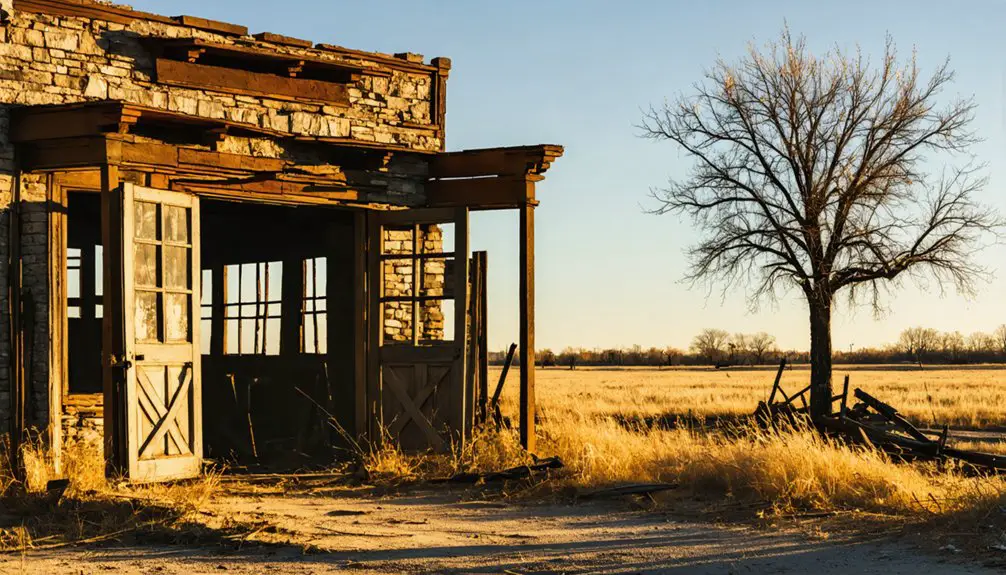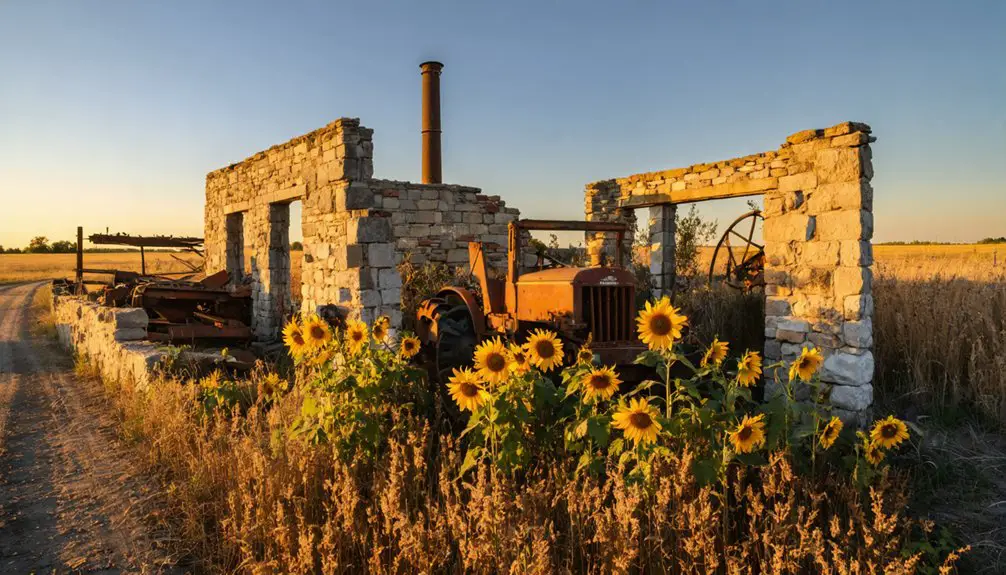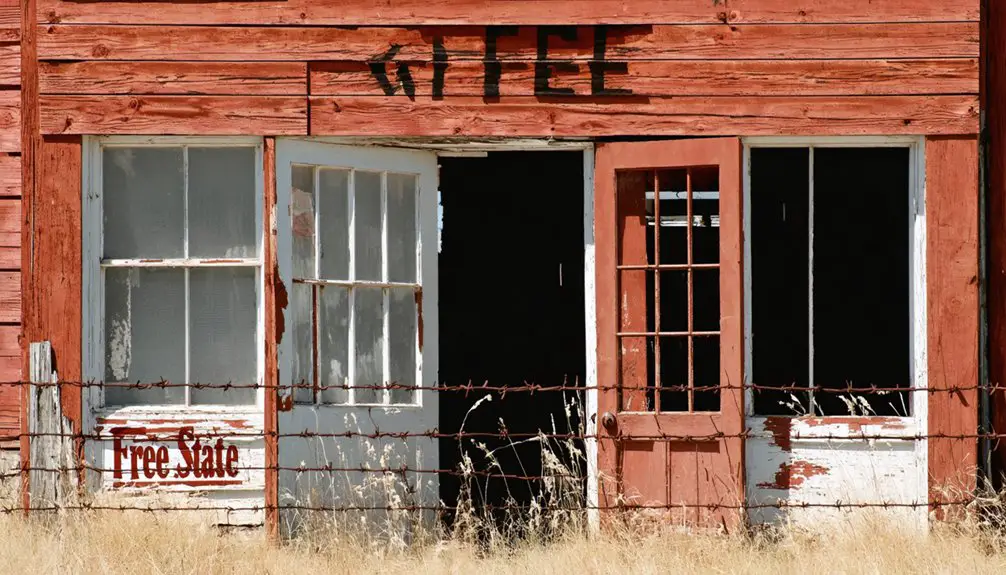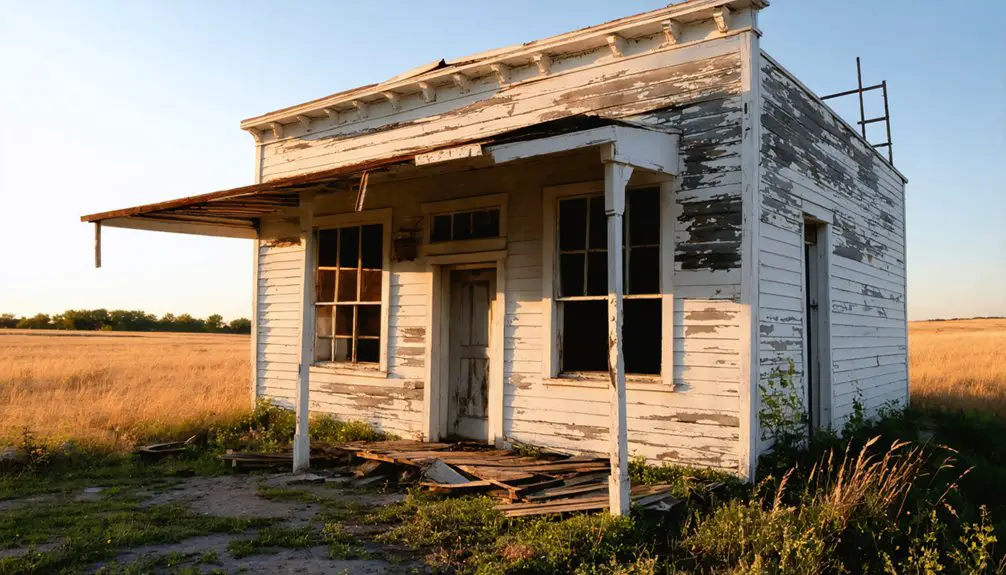You’ll find Cato’s ghost town remnants in Crawford County, Kansas, where John Rogers built the first store in 1854. The settlement flourished as a trading post during the contentious Cherokee Neutral Lands period, with settlers paying $1.50 to $4 per acre for homesteads. Today, the preserved one-room stone schoolhouse, built in 1869, stands as the town’s most prominent landmark. The annual Cato Days Festival reveals the deeper stories of this frontier community’s spirited past.
Key Takeaways
- Cato emerged in 1854 as a frontier trading post in Crawford County, Kansas, with John Rogers establishing the first store.
- The historic Cato School, built in 1869, is preserved as a National Historic Place by the Cato Historical Preservation Association.
- The settlement declined due to changing transportation patterns and service consolidation, eventually becoming a ghost town.
- Visitors can experience guided tours of architectural remnants and participate in the annual Cato Days festival celebrating local history.
- The town played a significant role during the Cherokee Neutral Lands period, facing conflicts between settlers and Native American claims.
Early Settlement and Founding Origins
Though Kansas hadn’t yet achieved statehood, Cato emerged in 1854 when John Rogers built the first store along a well-traveled route south of Fort Scott.
The settlement quickly took shape in Lincoln Township, Crawford County, near the Bourbon County line, despite being part of the contested Cherokee Neutral Lands. Woolery Coonrod Sr. and other pioneering families helped establish the initial settlement.
Early settler experiences centered around establishing essential services. E.J. Boring opened the first post office in 1858, naming it after Territorial Judge Sterling Cato. Much like Cato the Elder, who championed traditional Roman values, the town embraced conservative frontier principles.
A frontier post office, established by E.J. Boring in 1858, gave Cato its name in honor of Judge Sterling Cato.
Early commerce flourished as the town became a strategic stopping point between Fort Scott and Baxter Springs.
That same year, Chad Brown hosted the area’s first school session in a log structure on his farm, where teacher Emery Conditt charged $1.50 monthly per student.
These developments marked Cato’s transformation from frontier outpost to organized community.
Life in Cherokee Neutral Lands
Life in Cato during the Cherokee Neutral Lands period was marked by uncertainty as settlers faced competing claims between Cherokee rights, railroad interests, and their own homesteading ambitions.
Your neighbors might’ve joined the Land League resistance groups that formed to protect settler claims against both railroad expansion and federal land policies in the contentious territory.
Most settlers paid between $1.50 to $4 per acre to purchase their homesteads in the disputed territory.
You’d find families trying to establish farms while maneuvering complex treaty obligations that technically reserved the 800,000-acre territory for Cherokee settlement.
By 1869, tensions had escalated so much that military troops were called in by Governor Harvey to maintain order in the region.
Native Cherokee Settlement Rights
Despite being designated as Cherokee territory through an 1835 treaty, the Cherokee Neutral Lands in Kansas remained largely unoccupied by Cherokee settlers.
The tribes had historically been expelled from Ohio and retreated southward, making their connection to Kansas lands tenuous at best.
You’ll find that while the Cherokee Nation paid $500,000 for these 800,000 acres, their rights to settle the land were complicated by several factors that challenged Native sovereignty.
- The land was originally meant to serve as a buffer zone between tribes and white settlers, limiting Cherokee rights to establish permanent settlements.
- Although the Cherokee held legal title, they never developed significant communities in the area.
- The region’s geographic isolation from the main Cherokee territory made it difficult to maintain control.
- Ongoing pressure from white settlers and railroad interests ultimately led to the 1866 treaty that forced the Cherokee to cede these lands.
The American Emigrant Company attempted to purchase the lands in 1866, but the sale was later voided due to legal complications.
Settler Land Claim Disputes
Tensions over land claims in the Cherokee Neutral Lands erupted into violent confrontations between white settlers, railroad interests, and government officials throughout the 1860s.
You’d find settlers fiercely defending their homesteads despite lacking legal title, as they’d established farms and built lives on land they considered rightfully theirs.
When J.E. Joy purchased over 640,000 acres in 1866, land ownership disputes intensified.
Settlers formed the Land League to protect their claims through legal battles and direct action. They’d attack railroad survey teams and resist construction crews, forcing the government to deploy federal troops.
The conflict highlighted the stark contrast between settlers seeking affordable homesteads and railroad interests acquiring massive land holdings.
Many families who’d worked the soil for years faced potential eviction as formal land sales proceeded.
Cross-Cultural Territory Challenges
Between 1827 and 1866, the Cherokee Neutral Lands evolved from a carefully planned buffer zone into a contentious territory where three distinct cultures collided.
You’d find yourself caught between competing visions for the land – the Cherokee Nation’s sovereign rights, white settlers’ homesteading claims, and railroad companies’ development plans.
Cultural exchange became strained as territorial negotiations broke down, leading to armed conflicts and legal battles. The Supreme Court decisions ultimately favored railroad interests over Cherokee claims to the disputed territory.
- Cherokee Chief Lewis Downing fought to protect his nation’s legitimate purchase and occupation rights
- Settler Land Leagues formed to resist railroad expansion and federal troops
- Military forces from the 6th Infantry and 7th Cavalry arrived to enforce federal authority
- Railroad interests pushed for development, disrupting traditional land use patterns and sparking resistance
The once-peaceful buffer zone transformed into a flashpoint of cultural and economic tension, forever changing the landscape of southeast Kansas.
Educational Heritage and Schoolhouse Legacy
While Cato was still part of the Cherokee Neutral Lands in 1854, the community’s first educational endeavor began in a humble log structure on Chad Brown’s farm. Teacher Emery Conditt charged parents $1.50 monthly per student, establishing the foundation of Cato’s educational legacy.
In 1869, the community replaced the log cabin with a stone schoolhouse that would serve generations of local children until 1955. Located at 1151 North 200th Street, the historic schoolhouse stands as a testament to early Kansas education.
You’ll find the one-room stone schoolhouse still standing today as the town’s best-preserved building, maintained by the Cato Historical Preservation Association. This architectural proof of rural schooling served not just as a center of learning, but as the heart of community life. Every October, the schoolhouse comes alive during Cato Days Festival with educational presentations and tours that connect visitors to the region’s pioneer past.
The building remains freely accessible, offering you a glimpse into the determined spirit of frontier education that helped transform Cato from settlement to structured community.
Historical Significance in Crawford County

Established in 1854, Cato holds the distinction of being Crawford County’s first permanent settlement, marking the beginnings of organized community life in the region.
You’ll find that Cato’s economy thrived as an essential trading post, serving wagon trains and settlers moving through the area. The town’s strategic location near the borders of Missouri, Oklahoma, and Arkansas made it a significant hub for frontier commerce and migration. The town’s early success was established when Rogers built a store that became central to the community.
- Pioneer resilience showed through the town’s survival during the Civil War, despite regional bushwhacker activity.
- The settlement featured one of Kansas’ historic one-room schools and maintained necessary services.
- Local entrepreneurs like John Rogers and Peter Smith operated successful general stores.
- The town served as an important judicial reference point, named after Territorial Judge Sterling Cato.
From Frontier Trading Post to Ghost Town
After its founding in 1858, Cato’s trading post quickly became an essential frontier commerce hub under E.J. Boring, who established the post office named for Alabama lawyer Sterling Cato.
The trade dynamics centered on exchanging eastern goods for furs, with the brick store built by Peter Smith in 1867 symbolizing economic permanence along vital transportation routes.
Settlement patterns shifted dramatically after the 1866 treaty forced Cherokee land cessions, opening over 640,000 acres to railroad development and homesteaders.
You’ll find that this shift marked the beginning of Cato’s decline, as traditional trading post operations struggled to adapt to new economic realities.
The town’s fate was sealed by changing transportation patterns and service consolidation, with the historic brick store’s destruction by fire in 1994 marking the final chapter in Cato’s frontier story.
Preserving Cato’s Cultural Memory

You’ll find the historic Cato School building, now listed on both National and Kansas Registers of Historic Places, standing as a symbol of preservation efforts by the Cato Historical Preservation Association.
The Association’s monthly meetings at Arcadia Community Center keep the town’s memory alive through oral histories, photographs, and artifacts collected during annual community reunions.
Through ghost town tours and educational programs, you’re able to experience firsthand how this frontier trading post evolved while learning about the architectural remnants that mark Cato’s cultural significance.
Historical School Preservation
The Cato Historical Preservation Association maintains one of Crawford County’s most significant educational landmarks – the 1869 stone schoolhouse that served local children for nearly 90 years.
This rare stone structure stands as a testament to educational impact and pioneer determination, offering you a glimpse into early Kansas territorial life.
Through school preservation efforts, you’ll find:
- Free guided tours highlighting the one-room schoolhouse’s architecture and teaching methods
- Annual “Cato Days” celebrations featuring historical reenactments and live music
- Educational displays and interpretive signs detailing the $1.50 monthly tuition system
- Original structural elements showcasing 19th-century rural school design
Today, this National Register of Historic Places site continues to educate visitors about the crucial role schools played in frontier communities, preserving Cato’s legacy for future generations.
Community Memory Collection
Living stories and cherished memories of Cato’s pioneer days continue through dedicated preservation efforts by the Cato Historical Preservation Association.
You’ll discover rich oral histories during monthly community events at Arcadia Community Center, where descendants share tales of coal mining origins and early school experiences. Local volunteers bring history to life through storytelling sessions featuring notable figures like founder John Rogers and teacher Emery Conditt.
The association preserves these cultural memories through extensive archival collections, including photographs, documents, and personal letters from Cato’s peak era around 1910.
During annual Cato Days festivals, you can experience historical reenactments, including the dramatic shoot-out between Missouri border roughians and Kansas lawmen, while guided tours and educational activities connect you directly with the town’s pioneering spirit.
Ghost Town Heritage Site
Historical preservation anchors Cato’s enduring legacy through its centerpiece attraction – the Cato Stone School, now listed on both National and Kansas Registers of Historic Places.
You’ll find this ghost town tourism gem near Arcadia, where a $15,360 Heritage Trust Fund grant has helped overcome preservation challenges. The Cato Historical Preservation Association actively maintains this cultural landmark, keeping its doors open for free visits.
- Monthly meetings at the Arcadia Community Center coordinate ongoing restoration efforts
- The Coonrod family’s volunteer work and community donations support building maintenance
- Window replacements and roof restoration represent key completed preservation phases
- Annual reunions at the site keep the spirit of old Cato alive, connecting past to present
Political Climate and Territorial Disputes

During Kansas Territory’s tumultuous formation in 1854, political tensions exploded after Congress passed the Kansas-Nebraska Act, which allowed settlers to determine slavery’s fate through popular sovereignty.
In the area that would become Cato, deep political divisions emerged as pro-slavery and free-state factions battled for control. You’d have witnessed massive voter fraud, particularly when Missouri “border ruffians” flooded across the border to illegally influence elections.
The region’s territorial governance reflected this chaos, with two rival legislatures claiming power – one pro-slavery in Lecompton, another free-state in Topeka.
Judge Sterling G. Cato, a staunch pro-slavery advocate, further inflamed tensions by issuing arrest warrants for abolitionists and validating fraudulent election results, until his resignation in 1858 amid the escalating conflict.
Frequently Asked Questions
What Natural Disasters or Events Contributed to Cato’s Abandonment?
You’ll find flood damage and drought impact seriously affected the town, while a devastating 1994 fire destroyed the historic brick store, marking significant steps in nature’s push toward abandonment.
Were There Any Notable Crimes or Lawlessness in Cato’s History?
While specific crime incidents aren’t directly documented, you’ll find Cato faced typical frontier lawlessness. The town’s location in disputed Cherokee Neutral Lands and weak law enforcement created conditions ripe for violence.
Did Native American Tribes Maintain Any Presence in Cato After Settlement?
You’ll find Native American influence diminished rapidly after settlement, though some trading interactions continued. Cultural exchange between settlers and tribes became limited as Cherokee and Osage peoples were increasingly displaced.
What Businesses and Industries Existed Besides John Rogers’ Original Store?
Beyond the general store, you’d find a bustling town with William Shamblin’s blacksmith shop, Andy Linthicum’s shoe shop, William Telcamp’s harness shop, plus flour and sawmills supporting agricultural development and regional trade.
How Many Residents Lived in Cato During Its Peak Population?
You’ll find that Cato demographics peaked at 112 residents in 1910, marking the town’s most populous period before its population decline began. The numbers paint a picture of a modest pioneer settlement.
References
- https://legendsofkansas.com/cato-kansas/
- https://en.wikipedia.org/wiki/Cofachique
- https://www.youtube.com/watch?v=iB5rHT14eVI
- https://en.wikipedia.org/wiki/List_of_ghost_towns_in_Kansas
- https://www.ghosttowns.com/states/ks/cato.html
- https://en.wikipedia.org/wiki/Cato
- http://www.kansastowns.us/hdkt/townc.html
- https://fortscott.biz/news/cato-celebrates-its-pioneer-history-with-cato-days-oct-26
- https://www.kancoll.org/books/cutler/cherokee/cherokee-co-p2.html
- https://www.ksgenweb.org/archives/1912/n/neutral_lands.html



